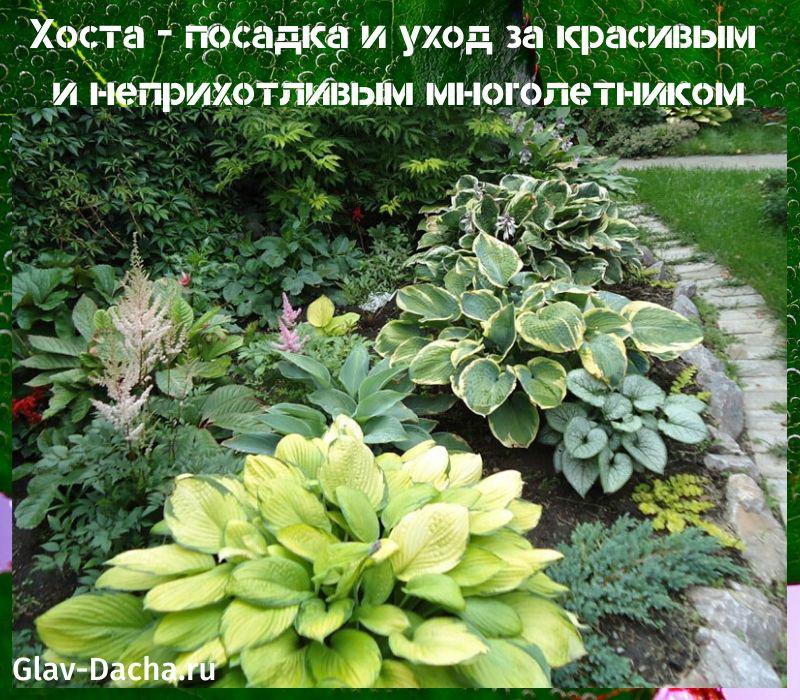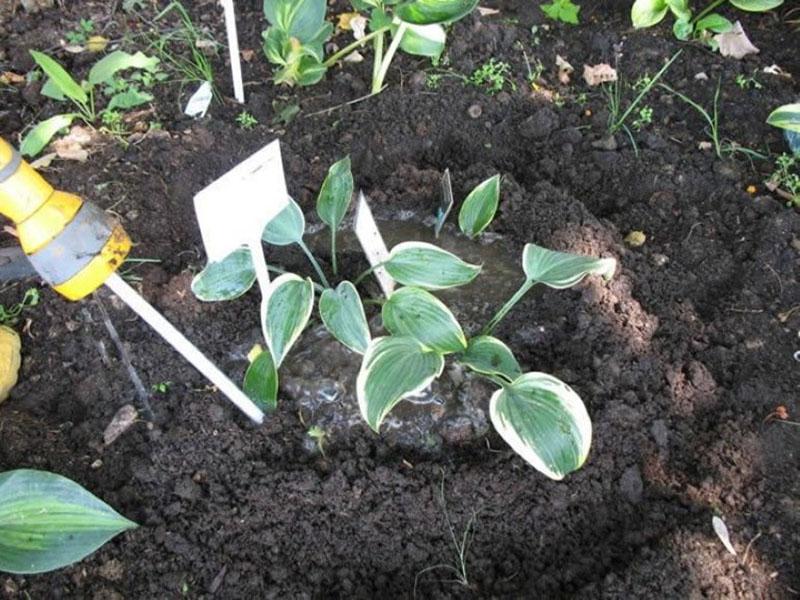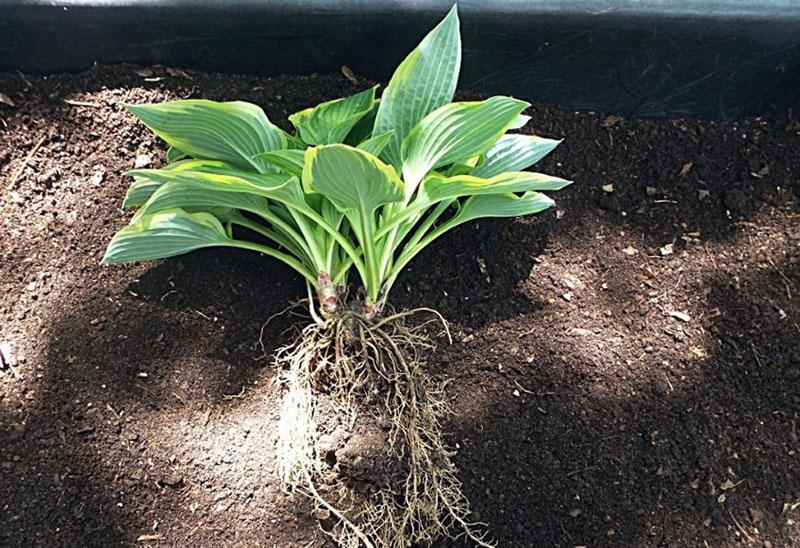Hosta - planting and caring for a beautiful and unpretentious perennial
 Green hearts of leaves, over which tall peduncles with delicate fragrant flowers rise, are all hosta, planting and caring for which even novice gardeners can do, if you know that the plant loves. One of its main advantages is the absence of high lighting requirements. Unlike most horticultural crops, the host is more comfortable in shady flower beds. It grows quickly and blooms every year with proper care. In its beauty, it is practically not inferior to lilies, with which the hosts have similar flowers. But it looks more gentle and charming, especially against the background of a rosette with colorful leaves.
Green hearts of leaves, over which tall peduncles with delicate fragrant flowers rise, are all hosta, planting and caring for which even novice gardeners can do, if you know that the plant loves. One of its main advantages is the absence of high lighting requirements. Unlike most horticultural crops, the host is more comfortable in shady flower beds. It grows quickly and blooms every year with proper care. In its beauty, it is practically not inferior to lilies, with which the hosts have similar flowers. But it looks more gentle and charming, especially against the background of a rosette with colorful leaves.
Hosta - planting and care: when and where is it better to plant

In nature, the hosta bush can grow in one place for up to 100 years, growing, but at the same time, not spreading over the territory.
Undoubtedly, this is another advantage of hosts. But its main advantage is foliage with a variety of colors.
There are many varieties and hybrids of the plant. They differ not only in the color of the leaves, but also in the size of the bush. There are miniature hosts no more than 15 cm in height and real giants over 1 m in height. The breeders managed to change the classic green color of the foliage by adding contrasting colors. Variegated, white or yellow hosts look gorgeous. And varieties with blue foliage will become the main decoration of the garden.
The perennial has a strong root system, takes root well and quickly. But in order for the bush to please with a lush rosette and flowering, choose a suitable place for it with good soil. And do not rush to plant, so that the seedlings do not freeze from too early or late planting.
Landing dates
 Hosta can be planted both in spring and autumn. However, in regions with a cold climate, it is better not to risk it and wait for spring. As soon as a stable above-zero temperature is established, you can proceed to spring planting. In the middle lane, flowers are planted no earlier than mid-May, and in the south, planting is possible already at the end of April.
Hosta can be planted both in spring and autumn. However, in regions with a cold climate, it is better not to risk it and wait for spring. As soon as a stable above-zero temperature is established, you can proceed to spring planting. In the middle lane, flowers are planted no earlier than mid-May, and in the south, planting is possible already at the end of April.
If you purchased seedlings in early spring, but it is still cold, store them in the cellar. Another room with a temperature of at least 5 ° C, but not higher than 10 ° C, is also suitable. Small seedlings can be left in the peat in which they are usually sold. It is better to plant large cuttings in a pot, and transfer them into open ground with the arrival of heat.
With regard to the autumn landing, it is carried out from late August to mid-September. It is not worth planting later. The bushes must have time to take root, get stronger and make a supply of nutrients.
Seat selection
 When choosing a place for hosts, keep in mind that none of its varieties will grow under the scorching rays. Only in the spring, on a site illuminated during the day, the bushes will be fine. But by the summer the situation will change dramatically. From excess lighting, the leaves will begin to lose color, fade and even dry out. Yellow varieties turn almost white, and blue ones become green-leaved. Also, the moisture that this plant needs quickly evaporates from the soil.
When choosing a place for hosts, keep in mind that none of its varieties will grow under the scorching rays. Only in the spring, on a site illuminated during the day, the bushes will be fine. But by the summer the situation will change dramatically. From excess lighting, the leaves will begin to lose color, fade and even dry out. Yellow varieties turn almost white, and blue ones become green-leaved. Also, the moisture that this plant needs quickly evaporates from the soil.
Plant flowers in shade or partial shade, where they will receive no more than 3-6 hours of sun per day.
When purchasing seedlings or seeds, immediately find out what the variety is called and what color it will have leaves.It depends on how much light he needs, for example:
- multi-colored species will retain their pattern only in midday partial shade, and in the morning and evening they need sun;
- blue and green hosts do better in shady areas;
- yellow species can grow in a sunny flower bed, but on condition that the sun is there only until lunchtime;
- blue varieties have enough sun for 2 hours a day.
If you are not sure which variety your flower belongs to, watch the leaves carefully. They instantly react to excess sun by darkening along the edge, faded spots and matte colors.
If you find at least one of these signs, urgently transplant the bush to a shaded area. Moreover, you can do this at any time, even in summer.
Hosta tolerates the procedure well and quickly takes root in a new place. It will be much worse for her if she does nothing and leave the flower under the scorching sun.
What kind of soil is needed
 Hosts love fertile, moist and slightly acidic soil, which is good for water and air. In natural conditions, they can be seen near reservoirs... But, despite the love for moisture, they will not grow in the "swamp", they will rot.
Hosts love fertile, moist and slightly acidic soil, which is good for water and air. In natural conditions, they can be seen near reservoirs... But, despite the love for moisture, they will not grow in the "swamp", they will rot.
Heavy clay soil is not suitable for flowering perennials. However, like sandy soil, in which moisture does not linger.
In problem areas, it is better to prepare soil mixture for planting holes. To do this, mix in equal parts:
- ordinary soil from the garden, but not clay, but fertile;
- deacidified peat;
- chopped bark (preferably composted).
For drainage, pour expanded clay on the bottom of the hole. It will protect the root system from waterlogging.
Hosta - planting and caring for a perennial
 When the frost has passed, the seedlings can be planted in the ground. Each delenka should have healthy roots at least 10 cm long and several living growth buds. The size of the landing holes depends on how large the division is. On average, pits are dug about 30 cm deep with the same width. If the host will grow in rows, leave at least 0.5 m between each bush.
When the frost has passed, the seedlings can be planted in the ground. Each delenka should have healthy roots at least 10 cm long and several living growth buds. The size of the landing holes depends on how large the division is. On average, pits are dug about 30 cm deep with the same width. If the host will grow in rows, leave at least 0.5 m between each bush.
Lay a drainage layer at the bottom, then add a good layer of nutritious soil. Set the hosta in the center, straighten the roots and sprinkle with earth, tamping it down. Water the plant and mulch peat so that it does not dry out quickly from the scorching spring sun.
When planting, do not deepen the root collar more than 2 cm. Otherwise, there is a risk of decay.
How to take care of a host in the country
 In general, decorative bushes are unpretentious. The most important thing depends on how well the landing site is chosen. But to keep them lush and blooming, a little attention will not hurt the host.
In general, decorative bushes are unpretentious. The most important thing depends on how well the landing site is chosen. But to keep them lush and blooming, a little attention will not hurt the host.
Caring for garden hosts includes a minimum of standard procedures:
- Watering. In hot summer, abundantly moisten the soil under the bushes at least 2 times a week. When doing this, try to keep water out of the leaves, especially if they are blue. In these varieties, the foliage is covered with a waxy coating, which is washed off with a stream of water. Then the characteristic original color disappears. In addition, spots of moisture in the sun "burn" the leaf.
- Mulching. Compost, shredded bark, litter and agrotextile. These materials can be used to cover or fill up the aisles, protecting the soil from drying out. In addition, weeds will not grow under such a cover, which will save you from weeding.
- Top dressing. Hosts only need 3 dressings per season: at the beginning of spring, before flowering and immediately after it. Apply nitrogen fertilizer or sprinkle dry chicken manure until leaves appear. In July, when the bushes bloom, feed with potassium-phosphorus fertilizers. The last feeding can be done with organic matter (mullein solution).
 As for pruning and shaping, a bush consisting only of leaves and no shoots does not need them. It will be enough just to remove damaged and dried leaves so that they do not spoil the view. Some gardeners also cut flower stalks, preventing them from blooming.But this mainly applies to varieties with nondescript flowering and small flowers. Most of the hosta species bloom beautifully and still smell amazing. Therefore, do not rush to remove the peduncles, except at the end of flowering. If the goal is not to collect the seeds, cut off the peduncles after the inflorescences wither.
As for pruning and shaping, a bush consisting only of leaves and no shoots does not need them. It will be enough just to remove damaged and dried leaves so that they do not spoil the view. Some gardeners also cut flower stalks, preventing them from blooming.But this mainly applies to varieties with nondescript flowering and small flowers. Most of the hosta species bloom beautifully and still smell amazing. Therefore, do not rush to remove the peduncles, except at the end of flowering. If the goal is not to collect the seeds, cut off the peduncles after the inflorescences wither.
Do I need to cover the host for the winter
 A characteristic feature of the perennial is the complete withering away of the ground part at the end of the growing season. Therefore, it makes no sense to cover the bushes - all the same, the foliage will dry out. But the root system can be protected with a layer of mulch, especially in the northern regions. In the southern regions of the host, it winters well even without mulch and grows back in spring.
A characteristic feature of the perennial is the complete withering away of the ground part at the end of the growing season. Therefore, it makes no sense to cover the bushes - all the same, the foliage will dry out. But the root system can be protected with a layer of mulch, especially in the northern regions. In the southern regions of the host, it winters well even without mulch and grows back in spring.
Reproduction hosts
 It is not difficult to get many new plants, because the hosta is actively growing and even sets seeds. Accordingly, it can be propagated both vegetatively, by dividing the bush, and with the help of seeds. But when using the second method, you will have to take into account some cultural features.
It is not difficult to get many new plants, because the hosta is actively growing and even sets seeds. Accordingly, it can be propagated both vegetatively, by dividing the bush, and with the help of seeds. But when using the second method, you will have to take into account some cultural features.
When and how you can divide a bush
 Like all perennials, over time, the young bush gives rise to new shoots, grows and becomes thick. This takes a different time for each variety. Some species can be divided after 5-6 years, other varieties can grow up to 10 years without planting.
Like all perennials, over time, the young bush gives rise to new shoots, grows and becomes thick. This takes a different time for each variety. Some species can be divided after 5-6 years, other varieties can grow up to 10 years without planting.
It is easy to determine that it is time to separate the bush and can be used for propagation by the leaves. They are getting smaller.
The division of the bush can be carried out at the following times:
- In early spring, when the plant is just beginning to wake up after wintering and releases shoots. Such hosts are easier to tolerate and take root faster.
- At the end of summer.
- Autumn, September.
If you plant a plant during a period when it has leaves (summer-autumn), it is better to cut them off. It is enough to leave cuttings up to 10 cm high so as not to overload the roots weakened after the procedure.
The minimum age of bushes that can be separated is at least 4 years for fast growing varieties. For species that develop slowly, you need to wait 8 years.
To get delenki, dig in a bush and remove it along with an earthen lump. Then divide the hosta with your hands, gently tearing the roots. If the bush is too thick, you can chop it up with a shovel or cut it with a knife.
How to propagate hosta from seeds
 The seed method at home is rarely used, because it requires more time and worries. In addition, the plants obtained in this way do not retain varietal characteristics. And some species are not at all able to set seeds and reproduce only vegetatively.
The seed method at home is rarely used, because it requires more time and worries. In addition, the plants obtained in this way do not retain varietal characteristics. And some species are not at all able to set seeds and reproduce only vegetatively.
Seeds for seedlings can be sown in early spring. Better buy a special substrate, loose and nutritious. Sow the hosta and sprinkle with a thin layer of soil on top. Seeds can be sown densely - their germination rate is not very high. For germination, greenhouse conditions are needed. Cover the container with plastic wrap and place in a warm place. After the emergence of seedlings, the shelter can be removed. When a pair of true leaves has formed, transplant the hosta into separate grow pots. Young hosta can be planted in open ground in late spring or early autumn.
Hosta - planting and caring for a potted plant
 Although the hosta is considered a horticultural crop, it can be grown as a pot plant if desired. Moreover, it does not need bright lighting and will feel good in partial shade. For indoor cultivation, hosts are better to choose varieties of compact sizes.
Although the hosta is considered a horticultural crop, it can be grown as a pot plant if desired. Moreover, it does not need bright lighting and will feel good in partial shade. For indoor cultivation, hosts are better to choose varieties of compact sizes.
Caring for a host in a pot is the same as for bushes growing in a garden. Water often without letting the soil dry out completely. During the period of active growth and flowering, do not forget to feed with fertilizers.
But for the winter, it is recommended to take the potted host to a cool room. This will create conditions as close to natural as possible, and she will be able to rest.
As you can see, planting and caring for a host in the open field is a simple and rewarding task. A cozy corner where she will hide from the sun, and a few dressings per season will allow the bush to grow and bloom to your joy.